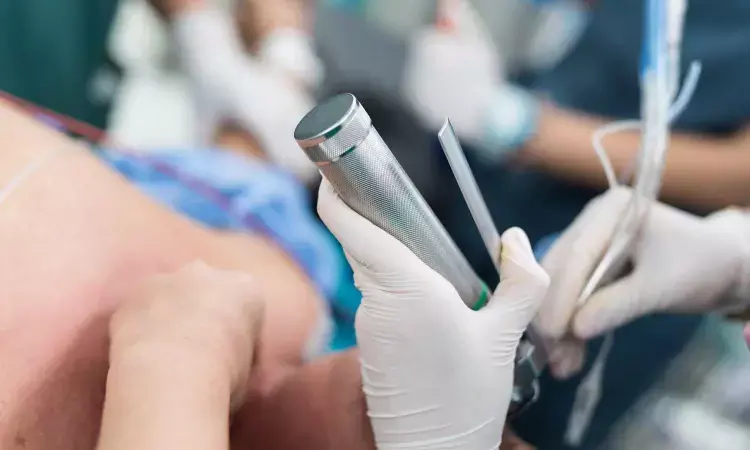- Home
- Medical news & Guidelines
- Anesthesiology
- Cardiology and CTVS
- Critical Care
- Dentistry
- Dermatology
- Diabetes and Endocrinology
- ENT
- Gastroenterology
- Medicine
- Nephrology
- Neurology
- Obstretics-Gynaecology
- Oncology
- Ophthalmology
- Orthopaedics
- Pediatrics-Neonatology
- Psychiatry
- Pulmonology
- Radiology
- Surgery
- Urology
- Laboratory Medicine
- Diet
- Nursing
- Paramedical
- Physiotherapy
- Health news
- Fact Check
- Bone Health Fact Check
- Brain Health Fact Check
- Cancer Related Fact Check
- Child Care Fact Check
- Dental and oral health fact check
- Diabetes and metabolic health fact check
- Diet and Nutrition Fact Check
- Eye and ENT Care Fact Check
- Fitness fact check
- Gut health fact check
- Heart health fact check
- Kidney health fact check
- Medical education fact check
- Men's health fact check
- Respiratory fact check
- Skin and hair care fact check
- Vaccine and Immunization fact check
- Women's health fact check
- AYUSH
- State News
- Andaman and Nicobar Islands
- Andhra Pradesh
- Arunachal Pradesh
- Assam
- Bihar
- Chandigarh
- Chattisgarh
- Dadra and Nagar Haveli
- Daman and Diu
- Delhi
- Goa
- Gujarat
- Haryana
- Himachal Pradesh
- Jammu & Kashmir
- Jharkhand
- Karnataka
- Kerala
- Ladakh
- Lakshadweep
- Madhya Pradesh
- Maharashtra
- Manipur
- Meghalaya
- Mizoram
- Nagaland
- Odisha
- Puducherry
- Punjab
- Rajasthan
- Sikkim
- Tamil Nadu
- Telangana
- Tripura
- Uttar Pradesh
- Uttrakhand
- West Bengal
- Medical Education
- Industry
Video laryngoscopy increased rate of successful intubations in neonates, finds study

A recent study published in the New England Journal of Medicine highlighted a critical aspect of neonatal care in endotracheal intubation. This vital procedure is often performed in neonates in the delivery room or neonatal intensive care unit (NICU) and can be fraught with challenges in achieving successful intubation on the first attempt.
The study revealed that repeated attempts at endotracheal intubation in neonates are associated with increased adverse events. Traditionally, clinicians have relied on direct laryngoscopy which helps to visually inspect the airway using a laryngoscope. However, this approach often falls short with fewer than half of first attempts proving successful.
This calls for video laryngoscopy which is equipped with a camera at the tip of the blade that provides a real-time view of the airway on a screen. This technology showed promise in enhancing the success rates of intubation in adults and children, yet, its effectiveness in neonates remained uncertain until now.
The study was conducted at a single center and randomly assigned neonates to either the video-laryngoscopy group or the direct-laryngoscopy group. The results were stratified based on gestational age and the primary outcome measured was successful intubation on the first attempt which was determined by exhaled carbon dioxide detection.
The study analyzed data from 214 neonates in the trial and found that 74% in the video-laryngoscopy group achieved successful intubation on the first attempt when compared to the 45% in the direct-laryngoscopy group. The median number of attempts to achieve successful intubation was significantly lower in the video-laryngoscopy group.
The study also evaluated physiological parameters during intubation. Neonates in the video-laryngoscopy group experienced higher median oxygen saturations and heart rates when compared to the individuals in the direct-laryngoscopy group by indicating potential benefits in terms of patient safety and comfort.
This research underlines the advantages of video laryngoscopy in neonatal intubation procedures. This technology has the potential to revolutionize neonatal care by offering a clearer and more navigable view of the airway, this reduces the need for repeated attempts and minimizing associated risks. Further studies may be imperative to explore long-term outcomes and broader applicability which can add to the existing evidence for the integration of video laryngoscopy into neonatal intensive care units and delivery rooms worldwide.
Reference:
Geraghty, L. E., Dunne, E. A., Ní Chathasaigh, C. M., Vellinga, A., Adams, N. C., O’Currain, E. M., McCarthy, L. K., & O’Donnell, C. P. F. (2024). Video versus Direct Laryngoscopy for Urgent Intubation of Newborn Infants. In New England Journal of Medicine. Massachusetts Medical Society. https://doi.org/10.1056/nejmoa2402785
Neuroscience Masters graduate
Jacinthlyn Sylvia, a Neuroscience Master's graduate from Chennai has worked extensively in deciphering the neurobiology of cognition and motor control in aging. She also has spread-out exposure to Neurosurgery from her Bachelor’s. She is currently involved in active Neuro-Oncology research. She is an upcoming neuroscientist with a fiery passion for writing. Her news cover at Medical Dialogues feature recent discoveries and updates from the healthcare and biomedical research fields. She can be reached at editorial@medicaldialogues.in
Dr Kamal Kant Kohli-MBBS, DTCD- a chest specialist with more than 30 years of practice and a flair for writing clinical articles, Dr Kamal Kant Kohli joined Medical Dialogues as a Chief Editor of Medical News. Besides writing articles, as an editor, he proofreads and verifies all the medical content published on Medical Dialogues including those coming from journals, studies,medical conferences,guidelines etc. Email: drkohli@medicaldialogues.in. Contact no. 011-43720751


